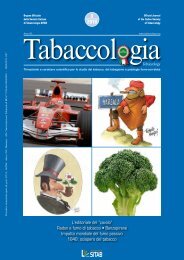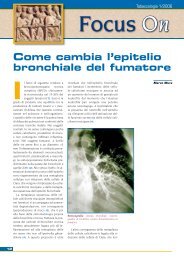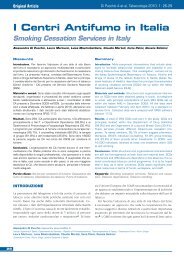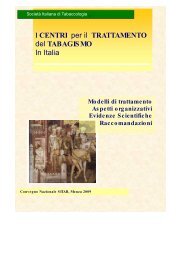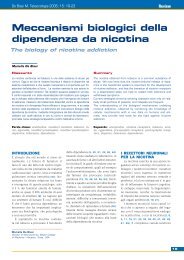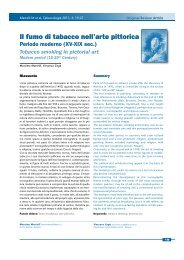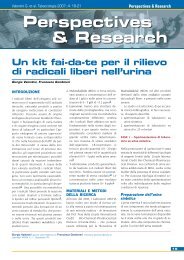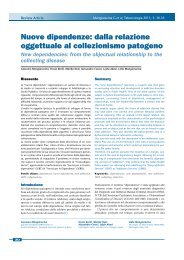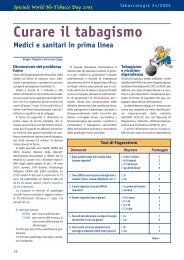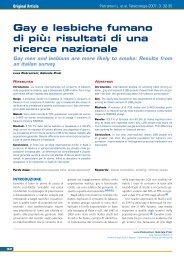Scarica n. 3/2003 - Società Italiana di Tabaccologia
Scarica n. 3/2003 - Società Italiana di Tabaccologia
Scarica n. 3/2003 - Società Italiana di Tabaccologia
Create successful ePaper yourself
Turn your PDF publications into a flip-book with our unique Google optimized e-Paper software.
Mura M. et al, <strong>Tabaccologia</strong> <strong>2003</strong>; 3: 23-28<br />
Review<br />
Strategie <strong>di</strong> oncoprevenzione con<br />
antiossidanti nei confronti<br />
dei ra<strong>di</strong>cali liberi del fumo <strong>di</strong> tabacco<br />
Strategies of oncoprevention with antioxidants towards reactive oxygen<br />
species in tobacco smoke<br />
M. Mura, V. Zagà, M. Fabbri<br />
Riassunto<br />
I ra<strong>di</strong>cali liberi dell'ossigeno (reactive oxygen species - ROS) sono specie molto reattive che danno origine a reazioni a catena<br />
in grado <strong>di</strong> automantenersi e amplificarsi. Il fumo <strong>di</strong> sigaretta rappresenta una formidabile sorgente <strong>di</strong> ROS (1015 per aspirata,i<br />
quali si possono sud<strong>di</strong>videre in due <strong>di</strong>fferenti gruppi: ra<strong>di</strong>cali a lunga emivita nella fase corpuscolata (fase tar) e ra<strong>di</strong>cali a<br />
breve emivita nella fase aeriforme (fase gas). Essi contribuiscono a rendere il fumo <strong>di</strong> sigaretta un carcinogeno completo, dal<br />
momento che può agire sia come iniziatore che come promotore. La strategia terapeutica e preventiva pertanto deve essere<br />
volta ad aumentare le <strong>di</strong>fese antiossidanti degli organi colpiti, in modo da ristabilire l'equilibrio tra ossidanti ad antiossidanti a<br />
favore <strong>di</strong> questi ultimi. Numerosi agenti sono attualmente allo stu<strong>di</strong>o, ed in questo ambito la sostanza più promettente risulta<br />
essere la N-acetil-L-cisteina (NAC), che in numerosi stu<strong>di</strong> in vitro, sugli animali e recentemente anche sull'uomo, si è <strong>di</strong>mostrata<br />
in grado <strong>di</strong> ridurre e prevenire il danno genotossico indotto dai ROS del fumo <strong>di</strong> tabacco.<br />
Parole chiave: ra<strong>di</strong>cali liberi, stress ossidativo, fumo <strong>di</strong> sigaretta, danno genotossico, N-acetil-Lcisteina.<br />
Abstract<br />
Reactive Oxygen Species (ROS) are very reactive molecules and atoms, giving rise to chain reactions that are able to maintain<br />
and amplify themselves. Cigarette smoke is an extraor<strong>di</strong>nary source of ROS (1015 for every aspiration), that can be sub<strong>di</strong>vided<br />
in 2 groups: ra<strong>di</strong>cals with long half-life in the corpuscular phase (tar phase) and ra<strong>di</strong>cals with short half-life in the aeriform phase<br />
(gas phase). These ra<strong>di</strong>cals contribute to make cigarette smoke a complete carcinogen agent, as it can act both as initiator<br />
and promoter. Consequently, therapeutic and preventive strategy should aim at increasing the antioxidants defences of the<br />
damaged organs and restoring the balance between oxidants and oxidants. A large amount of protective agents are being<br />
stu<strong>di</strong>ed at the moment, and the most promising substance in this area is N-acetylcysteine (NAC). In numerous stu<strong>di</strong>es in vitro,<br />
in animals and recently also in human beings, NAC has shown the capacity of reducing and preventing the genotossic damage<br />
induced by ROS of tobacco smoke.<br />
Keywords: free ra<strong>di</strong>cals, oxidative stress, cigarette smoke, genotossic damage, N-Acetyl-Cysteine.<br />
Introduzione<br />
Il fumo <strong>di</strong> sigaretta rappresenta una<br />
importante sorgente <strong>di</strong> ra<strong>di</strong>cali liberi sia<br />
nella sua componente gassosa (fase gas)<br />
che corpuscolata (fase tar). Essi contribuiscono<br />
a rendere il fumo <strong>di</strong> sigaretta<br />
un carcinogeno completo, dal momento<br />
che può agire sia come iniziatore che<br />
Marco Mura<br />
Dottorato <strong>di</strong> Ricerca in Scienze Pneumo-car<strong>di</strong>o-toraciche<br />
Università degli Stu<strong>di</strong> <strong>di</strong> Bologna,<br />
Research Fellow - University of Toronto<br />
Cristallografia della struttura<br />
della Vitamina E<br />
Vincenzo Zagà<br />
Presi<strong>di</strong>o <strong>di</strong> Pneumotisiologia - AUSL Città <strong>di</strong> Bologna,<br />
<strong>Società</strong> <strong>Italiana</strong> <strong>di</strong> <strong>Tabaccologia</strong>-SITAB<br />
Cristallografia della struttura<br />
del Betacarotene<br />
Mario Fabbri<br />
Direttore della Scuola <strong>di</strong> Specializzazione in<br />
Malattie dell'Apparato Respiratorio<br />
Università degli Stu<strong>di</strong> <strong>di</strong> Bologna<br />
23



